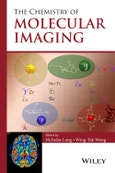- Covers all of the fundamentals of modern imaging methodologies, including their techniques and application within medicine and industry
- Focuses primarily on the chemistry of probes and imaging agents, and chemical methodology for labelling and bioconjugation
- First book to investigate the chemistry of molecular imaging
- Aimed at students as well as researchers involved in the area of molecular imaging
Table of Contents
Preface ix
List of Contributors xi
1 An Introduction to Molecular Imaging 1
Ga-Lai Law and Wing-Tak Wong
1.1 Introduction 1
1.2 What is Positron Emission Tomography (PET)? 3
1.3 What is Single Photon Emission Computed Tomography (SPECT)? 6
1.4 What is Computed Tomography (CT) or Computed Axial Tomography (CAT)? 8
1.5 What is Magnetic Resonance Imaging (MRI)? 11
1.6 What is Optical Imaging? 15
1.7 What is Ultrasound (US)? 19
1.8 Conclusions 22
References 24
2 Chemical Methodology for Labelling and Bioconjugation 25
Lina Cui and Jianghong Rao
2.1 Introduction 25
2.2 Chemical Methods 25
2.3 Site-Specific Modification of Proteins or Peptides 36
2.4 Conclusions 45
References 45
3 Recent Developments in the Chemistry of [18F]Fluoride for PET 55
Dirk Roeda and Frédéric Dollé
3.1 Introduction 55
3.2 Fluorine-18: The Starting Material 56
3.3 Reactive [18F]Fluoride 56
3.4 The Radiofluorination 58
3.5 Labelling of Large Biological Molecules 65
3.6 Conclusions 70
References 70
4 Carbon-11 Nitrogen-13 and Oxygen-15 Chemistry: An Introduction to Chemistry with Short-Lived Radioisotopes 79
Philip W. Miller Koichi Kato and Bengt Långström
4.1 Introduction 79
4.2 Carbon-11 Chemistry 81
4.3 Nitrogen-13 Chemistry 93
4.4 Oxygen-15 Chemistry 98
4.5 Conclusions 99
References 99
5 The Chemistry of Inorganic Nuclides (86Y 68Ga 64Cu 89Zr 124I) 105
Eric W. Price and Chris Orvig
5.1 Introduction: Inorganic Nuclide-Based Radiopharmaceuticals 105
5.2 Radiopharmaceutical Design 107
5.3 Radiopharmaceutical Stability 108
5.4 86Yttrium Radiometal Ion Properties 110
5.5 68Gallium Radiometal Ion Properties 116
5.6 64Copper Radiometal Ion Properties 120
5.7 89Zirconium Radiometal Ion Properties 123
5.8 124Iodine Nuclide Properties 125
5.9 Conclusions 129
References 129
6 The Radiopharmaceutical Chemistry of Technetium and Rhenium 137
Jonathan R. Dilworth and Sofia I. Pascu
6.1 Introduction 137
6.2 Technetium and Rhenium Radiopharmaceutical Chemistry 139
6.3 Technetium and Rhenium(IV) 149
6.4 Technetium and Rhenium(III) 149
6.5 Technetium and Rhenium(I) 151
6.6 Imaging of Hypoxia with 99mTc 155
6.7 Technetium and Rhenium Diphosphonate Complexes 157
6.8 The Future for Technetium and Rhenium Radiopharmaceuticals 157
References 158
7 The Radiopharmaceutical Chemistry of Gallium(III) and Indium(III) for SPECT Imaging 165
Jonathan R. Dilworth and Sofia I. Pascu
7.1 Introduction to Gallium and Indium Chemistry 165
7.2 Gallium and Indium Complexes and Related Bioconjugates 166
7.3 Auger Electron Therapy with 111Indium 175
7.4 Prospects for 67Ga and 111In Radiochemistry 176
References 176
8 The Chemistry of Lanthanide MRI Contrast Agents 179
Stephen Faulkner and Octavia A. Blackburn
8.1 Introduction 179
8.2 Gadolinium Complexes as MRI Contrast Agents 180
8.3 Minimising the Toxicity of Gadolinium Contrast Agents 184
8.4 Rationalising the Behaviour of MRI Contrast Agents 185
8.5 Strategies for Increasing Relaxivity 188
8.6 Responsive MRI 192
8.7 Conclusions and Prospects 195
References 195
9 Nanoparticulate MRI Contrast Agents 199
Juan Gallo and Nicholas J. Long
9.1 Introduction 199
9.2 T2 Contrast Agents 200
9.3 T1 Contrast Agents 203
9.4 T1-T2 Dual MRI Contrast Agents 208
9.5 Water Solubilisation 209
9.6 Functionalisation and Surface Modification 213
9.7 Applications 216
9.8 Conclusions and Outlook 220
References 220
10 CEST and PARACEST Agents for Molecular Imaging 225
Osasere M. Evbuomwan Enzo Terreno Silvio Aime and A. Dean Sherry
10.1 Introduction 225
10.2 Diamagnetic CEST Agents 226
10.3 Paramagnetic Chemical Exchange Saturation Transfer (PARACEST) Agents 229
10.4 Responsive PARACEST Agents 230
10.5 In Vivo Detection of PARACEST Agents 233
10.6 Supramolecular CEST Agents 235
10.7 LipoCEST Agents 236
10.8 Conclusions 241
References 241
11 Organic Molecules for Optical Imaging 245
Michael Hon-Wah Lam Ga-Lai Law Chi-Sing Lee and Ka-Leung Wong
11.1 Introduction 245
11.2 Designing Molecular Probes for Bio-imaging 246
11.3 Different Types of Organic-based Chromophores and Fluorophores for Bioimaging 249
11.4 Mechanisms of Photophysical Processes and Their Applications in Molecular Imaging and Chemosensing 258
11.5 Two/Multi-photon Induced Emission and In Vitro / In Vivo Imaging 262
11.6 Time-Resolved Imaging 266
11.7 Bioluminescence in Molecular Imaging 267
11.8 Photoacoustic Imaging 269
11.9 Conclusion and Future Perspectives 270
References 270
12 Application of d- and f-Block Fluorescent Cell Imaging Agents 275
Michael P. Coogan and Simon J. A. Pope
Abbreviations 275
12.1 Introduction 275
12.2 d6 Metal Complexes in Fluorescent Cell Imaging 277
12.3 f-Block Imaging Agents 285
12.4 Conclusions 296
References 296
13 Lanthanide-Based Upconversion Nanophosphors for Bioimaging 299
Fuyou Li Wei Feng Jing Zhou and Yun Sun
13.1 Introduction 299
13.2 Fabrication of Ln-UCNPs Suitable for Bioimaging 299
13.3 Surface Modification of Ln-UCNPs 304
13.4 In Vivo Imaging Applications 306
13.5 Biodistribution and Toxicity of UCNPs 316
13.6 Future Directions 317
References 317
14 Microbubbles: Contrast Agents for Ultrasound and MRI 321
April M. Chow and Ed X. Wu
14.1 Introduction 321
14.2 Classification of Microbubbles 321
14.3 Applications in Ultrasound Imaging 324
14.4 Applications in Magnetic Resonance Imaging 327
14.5 Applications beyond US Imaging and MRI 330
14.6 Conclusions: Limitations Bioeffects and Safety 330
References 331
15 Non-Nanoparticle-Based Dual-Modality Imaging Agents 335
Reinier Hernandez Tapas R. Nayak Hao Hong and Weibo Cai
15.1 Introduction 335
15.2 PET/Optical Agents 336
15.3 SPECT/Optical Agents 341
15.4 MRI/Optical Agents 345
15.5 PET/MRI Agents 348
15.6 Conclusions 348
References 350
16 Chemical Strategies for the Development of Multimodal Imaging Probes Using Nanoparticles 355
Amanda L. Eckermann Daniel J. Mastarone and Thomas J. Meade
16.1 Introduction 355
16.2 Fluorescence-MRI 357
16.3 Near-Infrared Fluorescence/MRI 359
16.4 NIR-PET 368
16.5 Upconversion Luminescence 372
16.6 PET-SPECT-CT-MRI 376
16.7 Ultrasound 382
16.8 Magnetomotive Optical Coherence Tomography (MM-OCT) 383
16.9 Photoacoustic Imaging 384
16.10 Conclusions 384
References 385
Index 389








